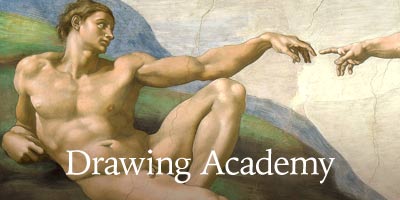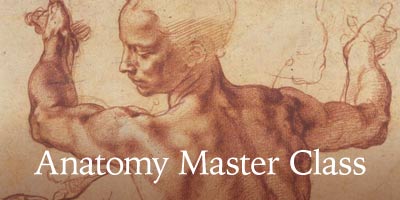Video by Vladimir London
Enroll in the Life Drawing Academy now!
How to Draw Hexagonal Prisms
Video by Vladimir London, a Life Drawing Academy tutor
In this video, you will find out special methods of drawing hexagonal prisms, which I developed for Life Drawing Academy Correspondence Course students. Drawing geometric bodies from life is a small, but important part of this course. It develops a good understanding of constructive drawing principles and a sense of perspective every proficient artist must have.
Let's begin with the simplest case - a standing hexagonal prism in one-point perspective. The horizontal line is divided into four equal parts and vanishing lines converge into one vanishing point. The standing prism can be inscribed into a cuboid. The top and bottom planes of this cuboid are squares. Circles inscribed into these squares help to plot hexagons. How to draw a hexagon using three methods is explained in a separate video.
When the bottom hexagon is in place, we can extend vertical edges to complete this prism. At the top, these edges cross the upper oval, which gives us another hexagon. As long as you draw hexagons inscribed into circles, your prism will look realistic. In this drawing, its frontal plane faces the viewer because it is a simple one-point perspective.

Now, I will show you my know-how of drawing from a two-point perspective. The depth is divided into four parts. Vanishing lines are converging to the left vanishing point. A circle in perspective appears as an elliptical oval. Its axis goes through the cross-point of the square diagonals. We know it is a perfect square because the inscribed oval touches its four sides in the middle of each side. These points are marked in green. Small red dots are the corners of the hexagonal prism. The hexagon is inscribed into the oval. The top plane of the cuboid follows the same two-point perspective. Its depth is also divided. Vertical edges connect the bottom hexagon with the top one. Here it is - a standing hexagonal prism in a two-point perspective.
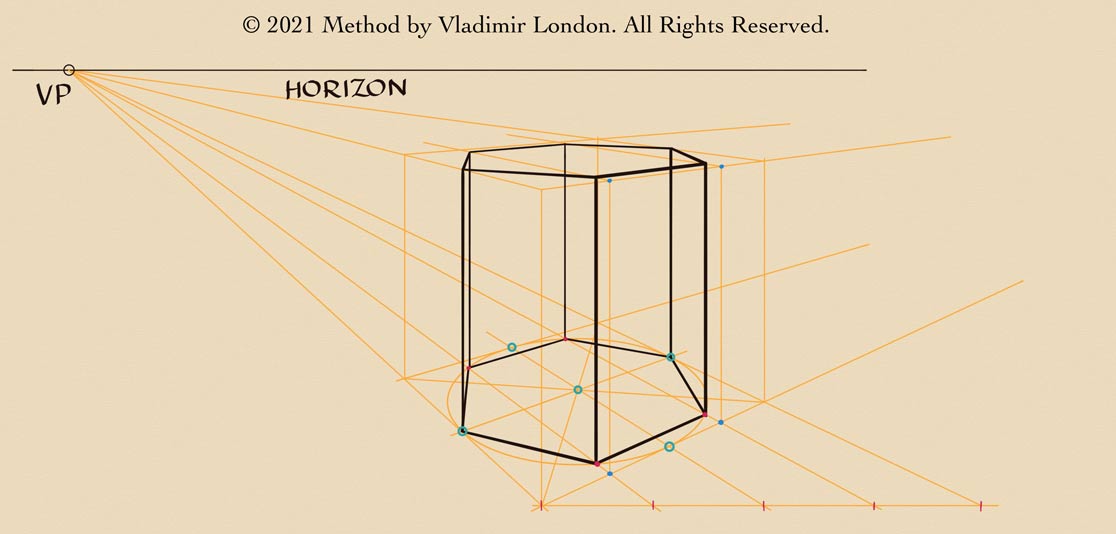
I will now show you my method of drawing a reclining hexagonal prism in a two-point perspective. The depth is divided in half. Vanishing lines point into two vanishing points. Four green dots indicate where the oval touches the horizontal square. The depth is divided into four equal parts. A vertical oval goes through two green dots. Its height is equal to the width of the horizontal oval. The vertical oval will serve as a guide for the hexagon. The height of this hexagon is between two red dots. It will be a modular prism. What is a module and how to draw modular prisms is explained in a separate video.
This drawing uses an oval that is located in the middle of the prism's hexagon. So, at the beginning, it is hard to tell where the ground is.
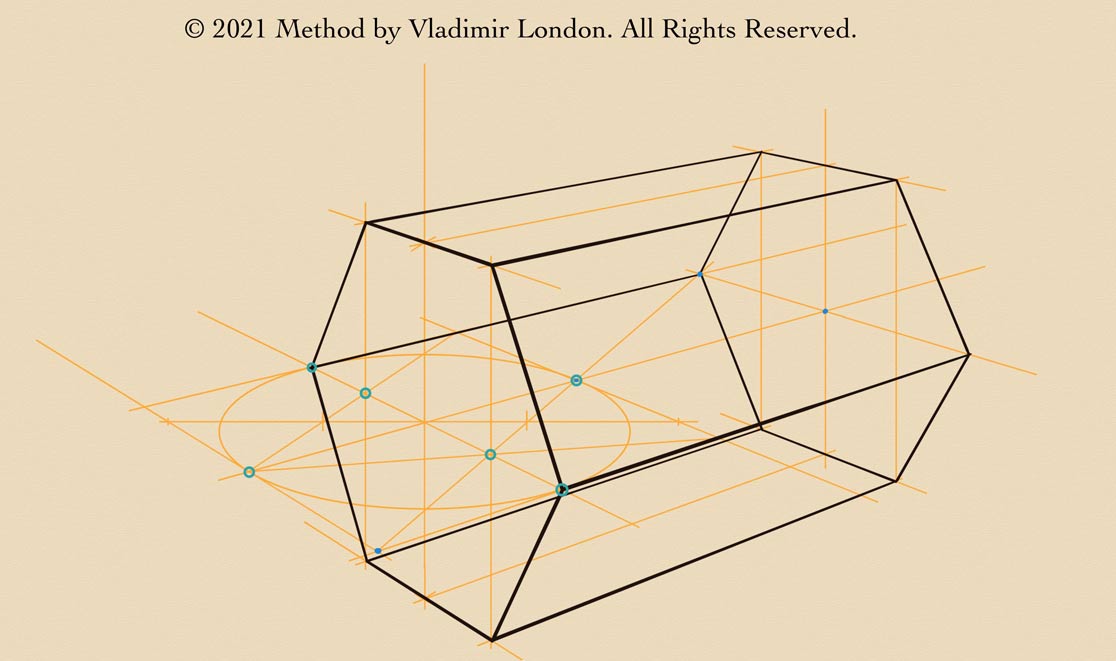
In the next drawing, I will show you how to build a reclining hexagonal prism starting from the ground. This method also uses my know-how. The depth is divided in half. To draw an elliptical oval in a two-point perspective. This oval is inscribed into a square. How to draw squares and cubes and avoid mistakes when drawing in perspective is described in a separate video.
The depth of the oval is divided into four equal parts. This oval is at the ground level. So, the prism will be built up from the ground. The vertical circle has the same height as the width of the horizontal oval. Once again, I will draw a modular prism, which means that its length will be one-and-a-half times greater than its width. We can use vanishing lines to plot the back side of this prism. When outlining a wireframe drawing, pay attention to the aerial perspective. Those lines that are closer to a viewer, must be bolder than the lines that are further away.
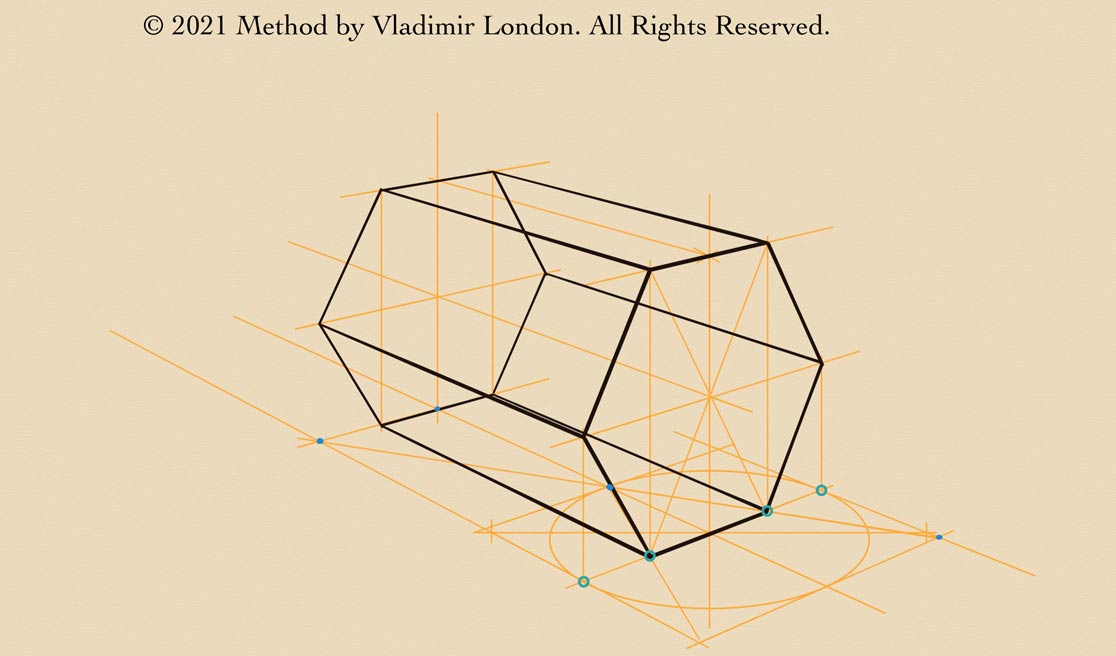
If you are not a Life Drawing Academy Correspondence Course student yet, check out what makes it the best drawing course.
To learn good drawing techniques, enroll in the Life Drawing Academy course:
Online Course
A self-study, self-paced course for you to learn fundamental methods of classical drawing and improve life drawing skills by watching video lessons and doing assignments
- Unlimited access to 52 life drawing video lessons
- Lifetime membership without deadlines
- Unlimited support from the Academy tutors
- Constructive critique of your artworks
- Member access to the Academy's Art community
- Place in the Academy's Students Gallery
- Exclusive members-only newsletter and bonuses
- Life Drawing Academy Diploma of Excellence in your name
One-time payment - Lifetime membership
$297 USD
Personal Tutoring Online + Online Course
The ultimate choice if you who would like to receive personal, one-to-one tutoring from the Academy teachers, which is custom-tailored to your skills and needs
- Everything in Online Course, plus:
- Dedicated team of art tutors
- Assessment of your current level of drawing skills
- Personalized curriculum tailored to your skills and goals
- Up to 100 drawing tasks with by-task assessment
- Unlimited one-to-one personal coaching with detailed per-task instructions and feedback
- Artwork critiques and results-oriented guidance
One-time payment - Lifetime membership
$997 USD



